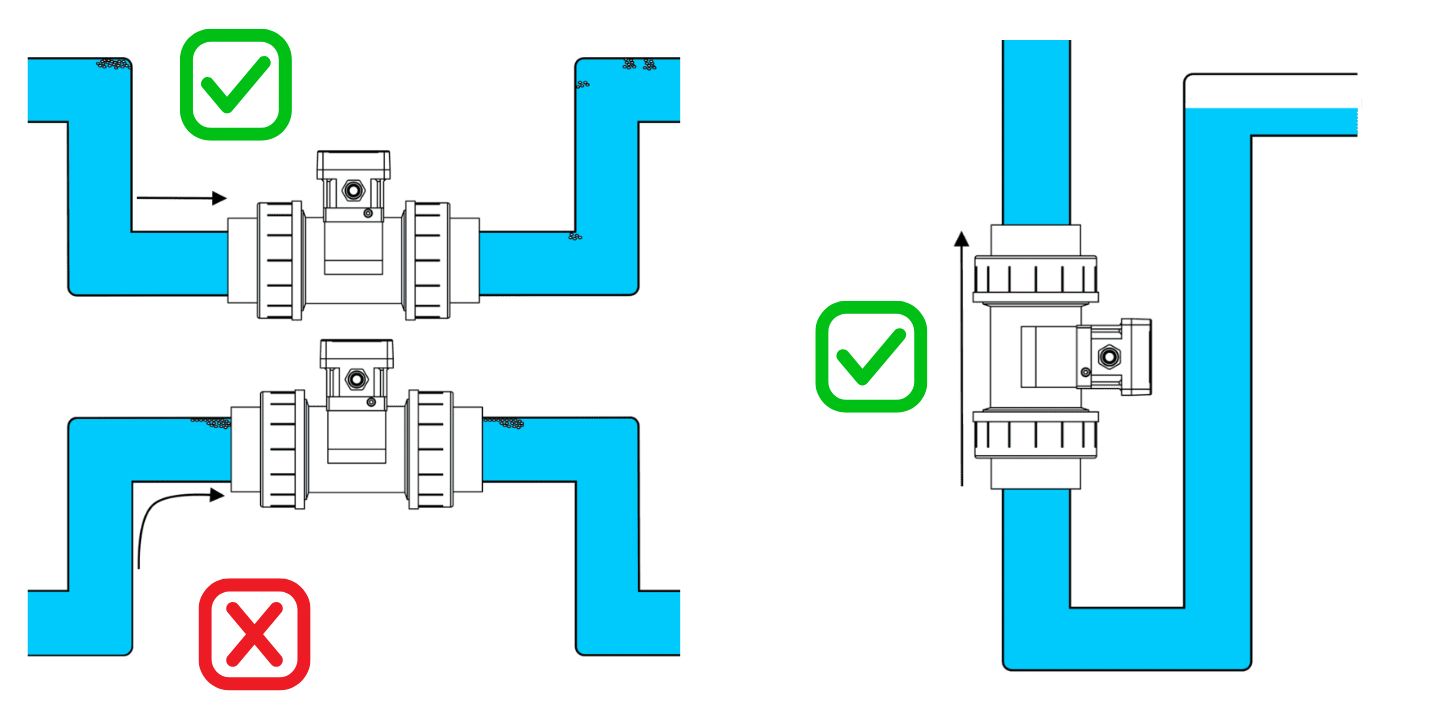เครื่องวัดการไหลคืออุปกรณ์ที่ใช้วัดอัตราการไหลของของไหล เช่น น้ำ สารเคมี อากาศ หรือแก๊ส ภายในระบบท่อ หากพบว่ามีค่าที่อ่านได้ผิดปกติหรือไม่คงที่ สาเหตุอาจไม่ใช่ปัญหาที่ตัวอุปกรณ์เสมอไป แต่บ่อยครั้งเกิดจากการติดตั้งที่ไม่ถูกต้อง
สำคัญที่ต้องเข้าใจว่าเครื่องวัดการไหลแต่ละประเภทมีข้อกำหนดการติดตั้งที่แตกต่างกันเล็กน้อยตามหลักการทำงาน บทความนี้จะอธิบายแนวทางการติดตั้งทั่วไปและคำแนะนำเฉพาะสำหรับแต่ละประเภทที่พบบ่อย
1. หลักการติดตั้งเครื่องวัดการไหลเบื้องต้น
วิธีที่ง่ายที่สุดในการติดตั้งเครื่องวัดการไหลให้ถูกต้องคือปฏิบัติตามคู่มือผู้ผลิต นอกจากนี้ การปฏิบัติตามแนวทางทั่วไปยังช่วยลดความผิดพลาดจากการติดตั้งได้มาก
1 ) อย่างน้อย 10D ด้านหน้า, 5D ด้านหลัง
เพื่อให้ค่าที่วัดได้เสถียรและแม่นยำ ควรมีท่อตรงก่อนและหลังเครื่องวัดการไหล โดยทั่วไป ท่อด้านหน้าควรมีความยาวอย่างน้อย 10 เท่าของเส้นผ่านศูนย์กลางภายใน (10D) และด้านหลังอย่างน้อย 5 เท่า (5D)
ทำไมจึงสำคัญ?
งานวิจัยพบว่าการติดตั้งเครื่องวัดหลังข้อศอกหรือข้อต่อจะทำให้การไหลเกิดการปั่นป่วนหรือหมุนวน ส่งผลต่อความแม่นยำของการวัด การมีท่อตรงที่เพียงพอจะช่วยให้การไหลกลับสู่สภาวะที่เสถียร
[1]

ตัวอย่าง: ถ้าเส้นผ่านศูนย์กลางภายในท่อ 4 ซม.
・ท่อตรงด้านหน้า = 10 × 4 ซม. = 40 ซม.
・ท่อตรงด้านหลัง = 5 × 4 ซม. = 20 ซม.
ถ้าไม่ทราบเส้นผ่านศูนย์กลางภายใน สามารถคำนวณได้จากเส้นผ่านศูนย์กลางภายนอกลบด้วย 2 เท่าของความหนาท่อ:
สูตร: ID = OD − 2 × ความหนาท่อ
[2]
2 ) หลีกเลี่ยงการติดตั้งหลังวาล์วหรือปั๊ม
อุปกรณ์เช่น ปั๊ม วาล์ว ตัวลดหรือขยายท่อ จะรบกวนการไหล เพื่อความแม่นยำ ควรติดตั้งเครื่องวัดการไหลก่อนวาล์ว และให้ห่างจากทางออกของปั๊ม
หากหลีกเลี่ยงไม่ได้ ควรเพิ่มความยาวท่อตรงด้านหน้าขึ้นเป็นอย่างน้อย 30D เพื่อให้การไหลกลับมานิ่งก่อนเข้าตัวเครื่อง

3 ) ติดตั้งในท่อที่มีของไหลเต็มหรือจุดต่ำที่มีการไหลขึ้น
เครื่องวัดควรติดตั้งในตำแหน่งที่ท่อเต็มของไหลตลอดเวลา หลีกเลี่ยงจุดสูงสุดซึ่งอาจเกิดฟองอากาศสะสม
ตำแหน่งที่เหมาะสม ได้แก่ จุดต่ำของท่อรูปตัว U หรือท่อแนวตั้งที่มีการไหลขึ้น

4 ) หลีกเลี่ยงบริเวณที่มีการสั่นสะเทือน; ใช้ที่คลุมป้องกันหากติดตั้งกลางแจ้ง
หากไม่ใช่อุปกรณ์ที่ออกแบบมาสำหรับการสั่นสะเทือนสูง ควรหลีกเลี่ยงการติดตั้งในบริเวณดังกล่าว โดยเฉพาะเครื่องวัดแบบแม่เหล็กไฟฟ้า ควรหลีกเลี่ยงใกล้แหล่งสนามแม่เหล็กแรงสูง เช่น มอเตอร์หรืออินเวอร์เตอร์ เพราะอาจรบกวนค่าศูนย์และความเสถียรของการวัด
การติดตั้งกลางแจ้งควรมีหลังคาหรือที่คลุมป้องกันเพื่อป้องกันแสงแดด ฝนจัด หรือหิมะ ซึ่งอาจกระทบต่อประสิทธิภาพและอายุการใช้งาน
2. ข้อควรพิจารณาสำหรับเครื่องวัดการไหลแต่ละประเภท
เครื่องวัดการไหลแบบอัลตราโซนิก
แบ่งเป็นแบบ transit-time และ Doppler
・Transit-time: วัดเวลาที่แตกต่างกันของคลื่นอัลตราโซนิกที่ไหลไปตามและย้อนกลับ เหมาะกับของเหลวใสไม่มีฟองอากาศหรือของแข็ง
・Doppler: ใช้การเปลี่ยนความถี่จากอนุภาคหรือฟองอากาศ เหมาะกับของเหลวที่มีสิ่งเจือปน
➜ ดูเพิ่มเติม:
การติดตั้งแบบ Z, V, N, W
รุ่น clamp-on รวม (all-in-one) เช่น LORRIC FU-ES ไม่ต้องใช้เจล ทำให้ติดตั้งง่ายขึ้น
➜ ดูสินค้า:
FU-ES Clamp-On Ultrasonic Flow Meter
เครื่องวัดการไหลแบบ Paddle Wheel
วัดการไหลจากการหมุนของใบพัดเล็ก แนะนำให้ติดตั้ง filter หรือ strainer ก่อนเครื่อง เพื่อป้องกันเศษวัสดุติดใบพัด
มุมติดตั้งที่เหมาะสมคือท่อแนวนอนที่เอียง 45° หรือ 135° หลีกเลี่ยงตำแหน่ง 12 นาฬิกา (บนสุด), 6 นาฬิกา (ล่างสุด), หรือ 3/9 นาฬิกา (ด้านข้าง) เพื่อป้องกันฟองอากาศ, ตะกอน, หรือการสึกหรอไม่เท่ากัน

เครื่องวัดการไหลแบบแม่เหล็กไฟฟ้า
ใช้สำหรับของเหลวที่นำไฟฟ้า ต้องแน่ใจว่าท่อเต็มและไม่มีฟองอากาศ แนะนำให้ติดตั้งอิเล็กโทรดในแนวนอน (ตำแหน่ง 3 และ 9 นาฬิกา) เพื่อหลีกเลี่ยงฟองหรือเศษตะกอน
ควรต่อสายกราวด์อย่างเหมาะสม และหลีกเลี่ยงบริเวณที่มีคลื่นแม่เหล็กรบกวน เช่น ใกล้มอเตอร์หรืออินเวอร์เตอร์
[8]
3. ปัญหาที่พบบ่อยในการติดตั้งเครื่องวัดการไหล
Q1: ติดตั้งแล้วอ่านค่าแปลกๆ ต้องตรวจอะไร?
A: ตรวจดูว่าลูกศรบนตัวเครื่องชี้ตรงกับทิศทางการไหลจริงหรือไม่ และท่อมีของไหลเต็มหรือเปล่า อย่าลืมทำตามคู่มือผู้ผลิต
Q2: ทำไมอ่านค่าไม่แม่นยำ?
A: สาเหตุอาจมาจากตำแหน่งติดตั้งผิด, มีฟองอากาศหรือเศษในของไหล, ความเร็วไหลไม่คงที่, ไม่ได้สอบเทียบเครื่อง หรือเซ็นเซอร์เสื่อม ควรเลือกเครื่องให้เหมาะสมและตรวจสอบสม่ำเสมอ
Q3: ถ้าค่าที่อ่านได้แกว่งมาก ต้องทำอย่างไร?
A: อาจเกิดจากท่อตรงด้านหน้าไม่พอ หรือเครื่องอยู่ใกล้ปั๊ม, วาล์ว, ข้อศอก ควรเพิ่มท่อตรงหรือใช้ flow conditioner
Q4: ถ้าเครื่องรั่วน้ำหรือแก๊ส?
A: ตรวจ O-ring ว่าขนาดและสภาพถูกต้อง (สำหรับแบบสอด) หรือพันเทป PTFE ที่เกลียว (สำหรับแบบเกลียว) และขันให้แน่น หลังติดตั้งควรทดสอบแรงดัน และเปลี่ยนชิ้นส่วนซีลถ้าจำเป็น
Resources
- ^ Li, Q.-X., Wang, C., Liu, X., Peng, J., & Ge, L. (2024). Study on the impact of pipeline installation conditions on ultrasonic gas flow measurement accuracy. Journal of Oil and Gas Technology, 46(3), 317–323. (Cited content on p. 317, para. 1: “The analysis concludes that the pre-installed elbow structure is the main cause affecting flow field distribution.”)
- ^ Liu, F.-L., Fan, S.-K. S., Ndi, E., & Tu, J.-F. (2021). An efficient no-shutdown pipe-fixing freezing design for water management system in hospitals during COVID-19: A case study. Water, 13(19), 2725.
- ^ Mathews, M. C. (2010). Installing flow meters on dairies. University of California Cooperative Extension. (Cited content on p. 4, para. 2: “Flow meters should be installed upstream of valves, as throttling valve jet disturbances affect measurement.”; para. 3: “Install flow meters at full-pipe and straight-pipe sections.”)
- ^ Holykell. (2021). Installation notes for water flow meters. Holykell Sensor Inc. (Cited content in paras. 1–3: Emphasizes matching installation direction arrow, ensuring full pipe, avoiding air pockets at the top point, and using vertical upward flow installation when appropriate.)
- ^ Armstrong International. (2021). Armstrong ultrasonic portable flowmeter – Installation guidelines. Armstrong International, Inc. (Cited content on p. 4, points 1, 3, and 5: Recommends upstream 10D and downstream 5D straight runs; 25D straight run after pumps; horizontal pipe installation on the side position for transducers.)
- ^ Calsense. (2021). Flow meter installation manual. Calsense. (Cited content on p. 2, para. 2: “Sensors are preferably installed on the top of the pipe, with deviations no more than 45° if necessary.”; para. 3: “Ensure flow direction matches the arrow and meet straight-run requirements.”)
- ^ Silver Instruments. (n.d.). Electromagnetic flow meter assembly & installation. Retrieved July 15, 2025, from Silver Instruments. (Cited content in para. 3: Emphasizes good grounding, avoiding proximity to strong electromagnetic interference (e.g., large motors), installing on upward vertical pipes or pipe low points to prevent partial filling.)